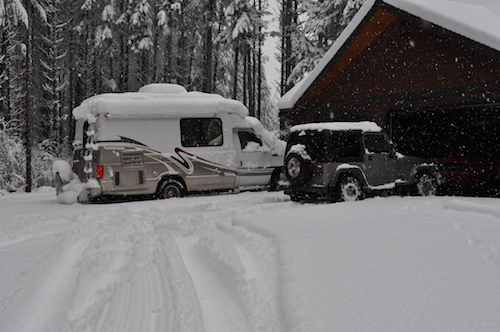Defining your use case is step one (which you did). If you don't want a system that has to do six opposite things, so much the better. What I mean is, like if you want a boat that you can trailer with a Prius, sleeps six, can explore shallow water creeks, and can cross oceans. That's a tough boat to find, and even if you could it would have a huge number of compromises. My primary use case is boondocking; yours is touring, mostly power post to power post, but with some one or two night dry camping. Great, it's defined.
In this case I'd say 200 watts sounds good. If you were in a consistently sunny area, and only in summer, I bet 100 would do. But with the price of panels being what it is (and yet batteries still being expensive), I see no need to cut it to the bare minimum.
Since you'll be on the move frequently, roof mounting makes sense (as long as every one of your campsites isn't in major shade). Since you'll be plugging in a lot, you can either go with the "my charger is nothing special but I'll just buy batteries once a year," or "I'm going to buy decent batteries and want them to last so I'll upgrade my charger." At least those are two approaches.
One thing I'm not sure of is your use of high draw appliances when dry camping, but we'll assume generator use for those.
I think what I'd focus on is the following:
1) Upgrade the safety aspects. For example, make sure that you can/do fuse each wire. Main battery fuses should have an AIC rating at least as high as the short circuit amperage of your battery bank.
2) I like battery switches, so they can be cut off if necessary. I also don't like seventeen cables going to each battery post (hence bus bars).
3) Carry out your charger plan (whatever upgrade path you decide on).
4) Check voltage drop so that you don't have any built in that you don't want there (you up wire size or shorten runs until the voltage drop gets to an acceptable level).
5) Mount 200 watts on the roof, run wiring and appropriate fusing, install solar controller.
6) Depending on whether you go "good batteries to last" or "cheap batteries and replace when they die," you may want to get a battery monitor. The good ones have come down in price (whereas batteries have not!).
I'm going to encourage you to consider doing it yourself if you are comfortable with it (or if you can get comfortable with it). Reason I say that is it is not rocket science, and there are knowledgeable folks here to talk to about it. I know there are some real pros out there, but despite that, I've seen so many sub-par installations. Excessive voltage drop, silicone globs, poorly planned controller location, inadequate fusing, etc. I'm not a pro (far from it), but when I do my own work I have two big advantages: One is that I don't have to account for every (billable) minute of my time; and two is that I can take the time to learn things and also to make those little tweaks that give a nicer installation (and once I have knowledge I can use it over and over again). I guess that's three
I do get that there is nothing wrong with hiring things out. So on the other hand I shouldn't discourage you from doing that, I know.
Actually I'm in a similar boat right now. I'm trying to get my head around lithium batteries and their charging considerations (for a boat project not the Chinook... yet), and it's kind of like I'm going back to square one as they are different from lead acid batteries in many ways. It's like I have to break my "lead head" ways of thinking. Part of me wishes I could just hire someone to figure it all out for me! (But on the other hand I want the knowledge...)
Scott: Thanks for that photo of the 100 watt on your roof. That looks darned good!
When I said brackets in from the end what I meant (but didn't say well) was that oftentimes the brackets are put on the short ends (as you did), but the "standard placement" is to put them right out at the edges. Since brackets often flare a bit at the bottom (such as AM solar brackets), if you put them right at the edge on the inside short ends (by the hump), then they hold the panel a couple of inches away from the hump, so more overhang. I'll be mounting mine just far enough inward so that the panel can snug up to the hump like yours does. (And then of course on the outboard side they have to be in a bit further so they hit roof not air.)
